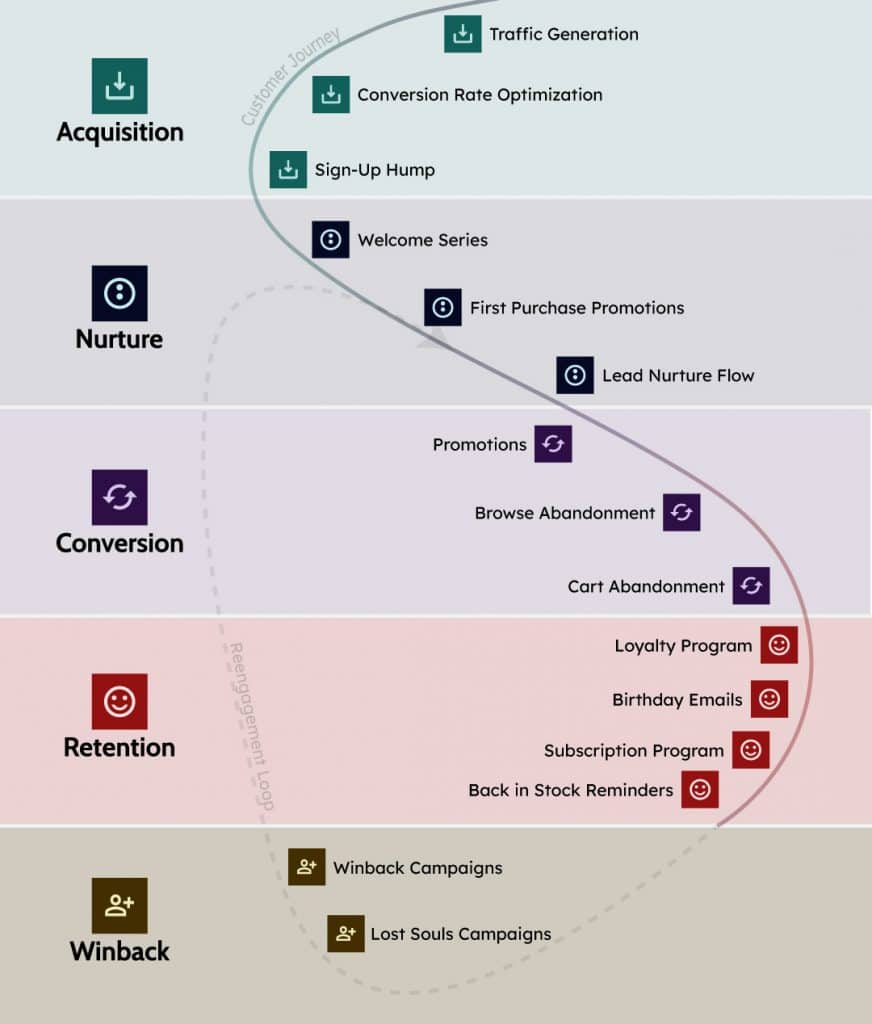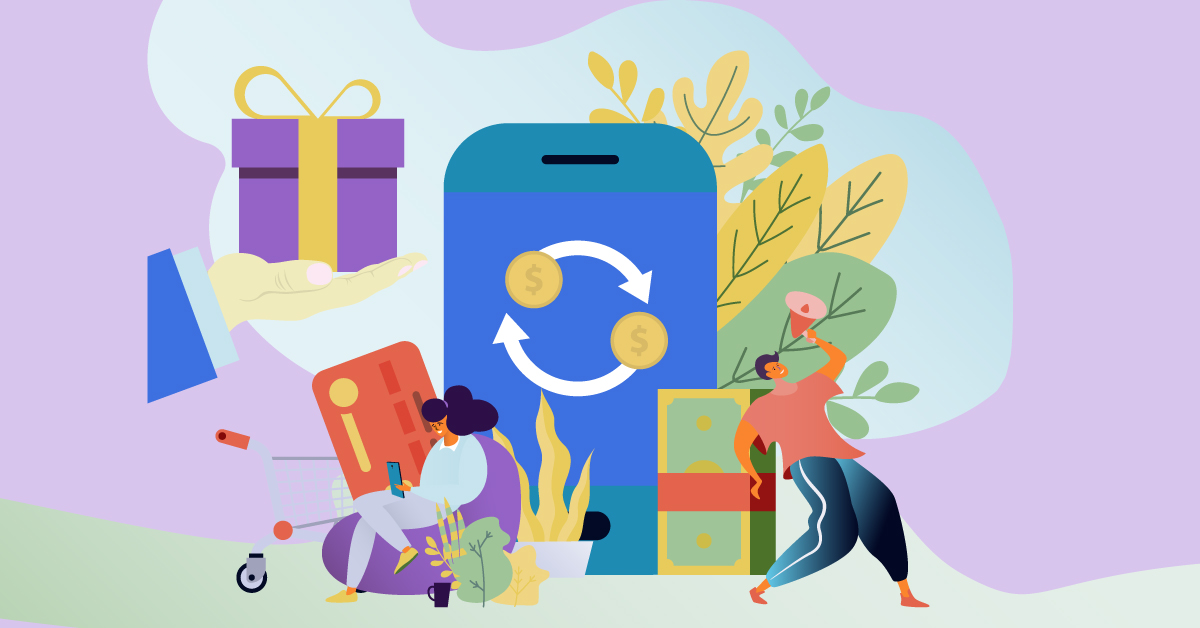Picture this: Instead of spending all day chasing new customers with expensive social media ads, you spend your time developing new products and watching orders flow into your store. With lifecycle marketing, you can turn that dream into a reality.
Lifecycle marketing is a marketing process focused on engaging with customers throughout their entire journey. Lifecycle marketing increases revenue for online stores by converting and retaining more customers.
A marketer’s job is to usher past, present, and future customers through the buyer’s journey with the end goal of nurturing leads into loyal customers. Here’s an example of how a customer moves through different lifecycle stages:
Window Shopper -> Potential Customer -> Customer -> Loyal Customer
In other words, customer lifecycle marketing is everything you do to grow your audience, convert audience members into customers, and retain those customers for a lifelong relationship.
This series aims to provide you with a deep dive into lifecycle marketing for ecommerce stores.
You’ll learn about the stages of lifecycle marketing and get specific tips for putting all this knowledge into action — whether you want to generate and nurture leads for your Shopify store, turn window shoppers into buyers, create loyal customers, or winback someone you’ve lost.
In this first chapter, we’ll outline some of the basic concepts related to lifecycle marketing and introduce you to a few benefits of using a lifecycle marketing strategy for your online store.
Down the Full Lifecycle Marketing Ebook
The Benefits of Lifecycle Marketing
The big-picture benefit of lifecycle marketing is that it aligns your marketing strategy with the entire customer journey to maximize customer lifetime value (LTV).
How does lifecycle marketing maximize customer LTV? By focusing on customer retention. After all, retaining an existing customer is much more cost-effective than acquiring a new customer.
Let’s walk through the benefits of lifecycle marketing.
Cost Savings
Lifecycle marketing concentrates on building profitable, long-term relationships with customers. There’s no wham-bam-thank-you-ma’am approach to sales in lifecycle marketing — that’s because lifecycle marketing experts know that retaining existing customers is the most effective way to increase customer lifetime value.
As we mentioned earlier, acquiring customers is more expensive than keeping them. So let’s look at some data to understand how that plays out in the real world.
The average customer acquisition cost (CAC) varies widely by industry. But on average, the CAC for online stores is between $50 and $100. For example, the average CAC for businesses selling home goods and using Google search ads is $87.13.
Let’s use that example to understand the potential cost savings benefit of lifecycle marketing:
| Traditional Sales Funnel | Lifecycle Marketing |
| Burden is on pushing customers through the funnel and acquiring new customers | Burden is shared equally between acquiring new customers and maintaining connections with existing customers |
| Imagine that 10 home goods customers are acquired with an average CAC of $87.13. Total cost: $871.30 | Imagine that 10 home goods customers are acquired with an average CAC of $87.13. Total cost: $871.30 |
| 10 customers make initial purchases valued at $50 each. Total revenue: $500 | 10 customers make initial purchases valued at $50 each. Total revenue: $500 |
| Without continued nurture, retention or winback phases, only two customers continue to make purchases. Added revenue: $200 | With continued nurture, retention or winback phases, seven customers continue to make purchases. Added revenue: $700 |
| Final outcome: -$171.30 | Final outcome: +$328.70 |
Yes, it’s a super simplified example, but you get the point. Lifecycle marketing increases the value of every customer, which increases revenue. Ultimately, it can even help lower your CAC by expanding the benefits of word-of-mouth, referral programs and other tools you can leverage when you have healthy relationships with your customers.
Time Savings
When you’re not constantly chasing new customers, you’ll save time and energy. Marketing teams can also save countless hours because large parts of lifecycle marketing campaigns can be automated.
That’s right. Instead of spending all day crafting new marketing messages, lifecycle marketers spend their time setting up data-driven automations that put sales on autopilot.
Related: Quantum Lifecycle Marketing Case Studies
For example, one of the most basic tactics in lifecycle marketing is sending follow-up messages to first-time purchasers in hopes of turning them into repeat customers. This type of messaging can be 100% automated with just a little bit of know-how.
Improved Customer Experience
We’ve mentioned customer retention a few times already. Lifecycle marketing improves retention because customer experience is baked in.
How, exactly?
Lifecycle marketing strives to optimize touchpoints at every stage of a customer’s journey. That means that after a customer makes a purchase, lifecycle marketers continue to build that relationship to generate brand advocates.
Good lifecycle marketing campaigns include post-purchase follow-up messages, customer satisfaction surveys, re-engagement campaigns and more — all designed to improve the customer experience.
Increased Purchase Frequency
Why is customer experience so important? Because it reduces churn rate and increases repeat purchases. Lifecycle marketing keeps brands top-of-mind with existing consumers and builds loyalty among your target audience.
If you sell shirts, lifecycle marketing strives to make your shirts the only ones in a customer’s closet. This type of loyalty is essential to staying competitive in today’s over-saturated ecommerce market.
Increased Customer Loyalty
Repeat customers are great. But loyal brand ambassadors are even better. As a result, customer lifecycle marketing strategies often include loyalty programs designed to create brand advocates who refer their friends and family to your store.
Better Personalization
Since lifecycle marketing focuses on every stage of the customer journey, marketers can take a more personalized approach. This is because you wouldn’t talk to a first-time website visitor the same way you would talk to a repeat VIP customer.
Email and SMS marketers can use segmentation to focus on the different customer lifecycle stages. Segmentation helps send more personalized messages based on where a customer is in the buying process.
Data-Driven Decisions
Finally, lifecycle marketing gives you the tools to understand your consumers while simultaneously helping you make better informed data-driven decisions.
With lifecycle marketing, you don’t have to make assumptions about what is working and what is not. Instead, you can easily measure your successes (or failures) by looking at crucial lifecycle marketing metrics like customer LTV.
The Stages of Lifecycle Marketing
Google “lifecycle marketing stages,” and you’ll get any number of results with different definitions and categories. But they all boil down to the same concepts. At Quantum, we focus on five stages of lifecycle marketing. Here are the primary stages of a customer journey:
- Acquisition. Acquisition is the process of acquiring (duh) new potential customers. Activities in this stage include traffic generation (SEO, social media, ads) and getting people to sign up for email and SMS lists.
- Nurture. Having done the work to generate a lead, you need to nurture them by demonstrating your authority and trustworthiness. Welcome campaigns, newsletters, content marketing, and first-purchase promotions are all critical in this phase.
- Conversion. Finally, you woo the customer into a decision. Conversion tactics include cart abandonment campaigns, first-purchaser promotions, reminder emails and cross-selling.
- Retention. Phases 1 through 3 cover the traditional sales funnel, and that’s where the work ends in many traditional marketing methods. But not with Quantum Lifecycle Marketing. You spent good money getting customers to this point; why would you abandon them right when they’re starting to grow? The retention phase is an extremely high ROI stage that involves activities like advocacy programs.
- Winback. Not every customer flows smoothly through their journey and becomes a loyal customer. When a customer falls off the track, the marketer’s job is to win them back through re-engagement campaigns.

How to Start With Lifecycle Marketing
So far, we’ve talked a lot about the philosophy of lifecycle marketing. But you still might be thinking, “How can I use lifecycle marketing at my store?”
In the next articles in this series, we will dive into an individual stage of the customer’s journey. We’ll start by going over acquisition tactics. Then, we’ll move on to the nurture and conversion stages and discuss how you can use email marketing to drive customer engagement. After that, we’ll focus on the bread and butter of lifecycle marketing: retention. Finally, we’ll talk about how you can win back lost customers.
To close things out, we’ll cover marketing automation and how online stores can put their sales and marketing on autopilot.
But first, let’s talk more about the stages of lifecycle marketing.
